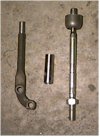-Note: Doing any part of this swap incorrectly will make your 510 far more dangerous than a 510 with worn-out, stock 30yr old parts. This is NOT for everyone to attempt!
Having driven this car for
well over two years now with this setup, I think it's a complete success! PROS Very accurate steering feel. Much quicker than stock steering ratio. CONS Cannot get more than .75 deg negative camber without other modifications. OTHER Wider track theoretically lowers front roll center. |
|
 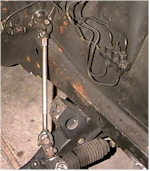 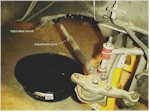 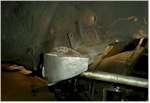 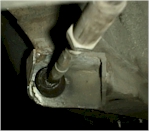 |
Converting a 510 with recirculating ball type steering to more accurate and more modern rack & pinion is not a simple task. The 510 is a relatively narrow car (the track is just 50.0"), making it difficult to find a car with the same track that has rack & pinion. While I know of no "bolt-in" upgrade, I was able to convert my 510 to rack & pinion without what I consider a major hassle. The reason I converted is twofold: 1) Increased clearance for an exhaust manifold on the drivers' side for my twincam V6 swap, as the 510 steering box takes up a fair amount of space where the V-6 exhaust needs to go. 2) Improved steering feel. I had driven a friend's 510 that had rack & pinion (converted by cutting much of the front subframe off and building a custom subframe), and going from that car to my 510 was a major eye opener. The suspension design between a 240Z (which has rack & pinion) and 510 is similar, but with some key detail differences. I decided to look into the possibility of putting the 240Z rack into the 510. Here's what I came up with: Differences: Spindle angle (angle between spindle and strut) are different (figure 1). 510 has forward running T/C rods (figure 2) the 240Z has rearward T/C rods. The 510 has a 50" track, the 240Z has 53" track, the 240Z has 10mm shorter steering knuckles and different bolt spacing. Similarities: The crossmember is basically identical, as are the lower control arms. The 240Z crossmember and lower control arm assembly will bolt on the 510 with no modifications. The two biggest issues here are T/C rods and the spindle angle. The 510 has T/C rods that run forward from the crossmember. The 240Z rack & pinion unit is mounted in front of the crossmember, and the steering would hit the T/C rods. The logical choice is to remove the 510 rods and make the T/C rods run rearward like the 240Z. This entails making a line from the lower control arm mounting point rearward until it hit a location you can create a mounting location. (This is required for suspension geometry reasons). I decided to retain the portion of the factory T/C rods that attached to the lower control arm, retaining the factory 240Z geometry for the simplicity - if you can call it that - factor. The spindle angle issue was solved by using the 240Z crossmember (which happened to save fabricating a mount on the 510 crossmember to mount the rack) and lower control arms. In addition to this, I measured the strut top center to strut top center on the 240Z and made sure there was room in the 510 strut tower to duplicate this measurement. There was enough room, so at this point the decision was made to go ahead with the 240Z front suspension on the 510. Taken from the 240Z: Struts assembly incl. strut inserts, springs, all disc brake components, steering knuckles, lower control arms, front crossmember, steering rack assembly, tie rod ends and front sway bar. Basically everything forward of the firewall that had anything to do with the suspension. Fabricated: T/C rods, T/C rod mounting points, steering rod from firewall to steering rack, spring perch adapter, bushing on end of 510 steering column. Modified: 510 steering column. 280ZX steering rod Removed from the 510: Steering box and forward running T/C rods. I removed the T/C rod mounts for a cleaner look, but functionally this is unnecessary. Here's how we fabricated the parts for the conversion: Thumbnails are HERE 1) The easiest piece to fabricate is the spring perch adapters. This allows the smaller diameter 240Z spring to be mounted in the 510 strut tower. This adapter is nothing more than a 6" diameter plate of 1/8" mild steel with 5 holes in it. 3 holes correspond to the holes in the 510 strut tower. The other 2 correspond to the 240Z strut tops (another hole is shared, as both strut tops have 3 studs).
2) Next we fabricated the
T/C rod
3) Next up: T/C mounting points. After marking where the mount needed to be, we had to cut some of the frame rail to have room to build the mount where we needed it. Building this "L" shaped piece is easy enough, it's getting the placement that is important. Making the mount a fairly good size makes placement of the mount itself not quite so critical, as there's room to mark and drill the hole where the T/C rod needed to mount for "correct" (in this case, same as a stock 240Z) geometry. Here's what the T/C assembly looks like when complete. 4) Something not realized until we got into this was that, when you remove the 510 steering box, there is no support for the firewall side of the steering rod that's in the 510 steering column! The 240Z column has a bushing in the firewall end to support it. Unfortunately, the Z and 510 columns don't interchange. Also, after looking at the angle from steering column to rack & pinion, it looked like the angle would be on the edge of what the steering column u-joint could handle. To reduce this angle, we shortened the 510 steering column by about 1.5" to it ended right at the firewall. We then shortened the 510 steering rod (the piece inside the column) about the same amount, and also made a simple aluminum bushing to support the firewall end. UPDATE (5/20/01) I converted the struts from the stock 240Z struts to shortened 200SX struts. This was done to get more negative camber up front as the spindle angle is different between the Z and SX struts. This conversion also requires SX brakes and hubs, as the Z pieces do not work on the SX struts
|
